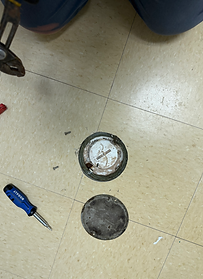The Problem, The Fix: A Quick Solution for a Salon's Clogged Toilet
The Problem: A salon faced a serious business disruption with a single, clogged toilet. As the only bathroom available for both staff and customers, the blockage meant they couldn’t operate normally and were losing business by the minute. The clog caused the toilet to back up, creating an urgent and unsanitary situation that needed to be resolved immediately.
The Solution: Our first step was a quick and accurate assessment. We ran water in the sink for several minutes and checked the floor cleanout to diagnose the issue. Since the sink drained properly and there was no standing water in the cleanout, we determined that the problem was isolated to the toilet itself and not a clog in the main sewer line. This precise diagnosis meant we could get straight to the fix without unnecessary work. We used a professional auger to clear the blockage, which was located approximately 6 feet into the line.
The Result: The blockage was successfully cleared, and the toilet was returned to perfect working order. The salon was able to reopen its bathroom to customers and staff quickly, preventing any further business disruption. The client was relieved to have the problem solved so fast and with such professionalism.




Things to Look Out For: What Causes a Clog?
Drain blockages can happen for many reasons, which is why most drain clearing services cannot be warrantied without a camera inspection. The cause of a clog is often not visible from the surface, and knowing what to avoid is key to preventing future issues.
Common Causes of Drain Blockages:
-
Bathroom & Personal Care Products:
-
Sanitary or "flushable" wipes
-
Paper towels
-
Feminine products and applicators
-
Tobacco products
-
Large amounts of hair (especially in bathtubs)
-
-
Kitchen Waste:
-
Grease, fats, and oils
-
Eggshells and coffee grounds
-
Large chunks of food
-
Heavy amounts of rice or pasta
-
-
Structural Issues:
-
Roots growing in the line
-
Obstructions in the sewer line
-
Crushed, broken, or eroded sewer pipe
-
Incorrect grade of the sewer line
-
Venting problems
-
